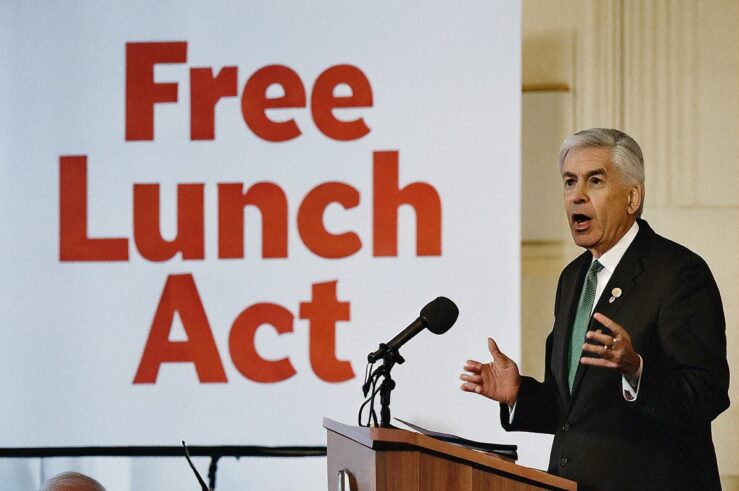One of my antitrust students recently pointed me to a television commercial that could inspire a great exam question. Unfortunately, I didn’t see the ad until I’d finished drafting this semester’s antitrust exam (which I’ve been grading…hence the absence from TOTM).
The T.V. commercial trumpets an agreement among the members of the American Beverage Association — including soft drink giants Coca Cola, Pepsico, and Dr. Pepper Snapple Group — not to sell high-calorie soft drinks in schools. Interspersed among scenes of a basketball game, a track meet, and a math class in which students clamor, Tracy Flick-like, to impress their attractive young teacher, three delivery people from rivals Coke, Pepsi, and Dr. Pepper smile at each other as they cooperatively restock a school’s soda machines. The voice-over announces:
Competition. It pushes us to work harder. To be better. To win.
But sometimes, even rivals realize they share a common goal.
America’s beverage companies have removed full calorie soft drinks from schools, reducing beverage calories by 88%. Together with schools, we’re helping kids make more balanced choices every day.
There’s also a print ad, which shows our three rival delivery folks standing outside a school with loads of diet drinks, juices, teas, and bottled waters. Just above the logos of Coca Cola, Pepsico, and Dr. Pepper Snapple, the text reads:
Together, we’ve replaced full-calorie soft drinks in schools with lower-calorie choices.
America’s beverage companies have teamed up to remove full-calorie soft drinks from schools. And we’ve replaced them with lower-calorie and small portion-sized options like juices, teas and waters — reducing beverage calories by 88%. Together with schools, we’re helping kids make more balanced choices every day. Learn more at Ameribev.org.
The actual agreement among the beverage manufacturers doesn’t just remove sugary sodas from schools. It also limits the sizes of the “healthy” drinks sold at schools. In elementary schools, juice and milk drinks cannot exceed 8 ounces. In middle school, the limit is 10 ounces. In high schools, it rises to 12 ounces. Sixteen ounce offerings are forbidden in all schools.
How can this arrangement not run afoul of the antitrust laws? Section 1 of the Sherman Act forbids any contract, combination, or conspiracy (i.e., any agreement) that unreasonably restrains trade. The Ameribev pact amounts to an agreement among competitors to limit market output — i.e., to “restrain trade” that otherwise would occur. The only legal question, then, is whether that trade restraint is “reasonable.”
It’s not. Or, at least, not in any way that antitrust would credit. The beverage companies’ agreement not to respond to consumer demand involves no integration of research or production, facilitates the creation of no new product or service, and occasions no reduction of transaction costs. Its only apparent function is to reduce market-wide output, and its profitability depends on the power to control the market. It is, in antitrust parlance, a “naked” output-reducing agreement. Antitrust doctrine has long declared such agreements among competitors to be unreasonable per se and thus illegal.
The parties to the agreement would no doubt retort that their trade restraint is reasonable because it addresses a vexing social problem — childhood obesity. But if they took that tack, they’d really be arguing that unbridled competition produces such attractive product/price offerings that consumers (albeit, young ones) consume too much. In other words, they’d be saying that competition, doing its thing (i.e., lowering price and making product offerings maximally attractive), is itself unreasonable, so that it’s “reasonable” to constrain competition’s excesses via agreement.
The Supreme Court has declared that argument a non-starter. In my favorite of Justice Stevens’ many antitrust opinions (the last of which was issued this week and will no doubt generate some discussion on TOTM), the Supreme Court reasoned that competitors cannot render a trade restraint “reasonable” by arguing that unfettered competition expands market output so much that it leads to antisocial results. The case, Professional Engineers, involved an ethical canon prohibiting professional engineers from discussing prices with prospective clients (and thus from competing on price) until the clients had selected their engineers. The engineer defendants argued that their restraint was reasonable because “bidding on engineering services is inherently imprecise, would lead to deceptively low bids, and would thereby tempt individual engineers to do inferior work with consequent risk to public safety and health.” In other words, the engineers maintained, their agreement to limit competition was reasonable because unhindered competition would lower prices to levels that threatened antisocial results.
The Supreme Court would have none of that. The Court conceded that vigorous price competition might lead to the sort of undesirable, antisocial result the engineers envisioned:
It may be, as petitioner argues, that competition tends to force prices down and that an inexpensive item may be inferior to one that is more costly. There is some risk, therefore, that competition will cause some suppliers to market a defective product.
But the Court insisted that the engineers’ attempt to justify their output-limiting agreement on grounds that competition threatens public safety was “nothing less than a frontal assault on the basic policy of the Sherman Act.” It then explained:
The Sherman Act reflects a legislative judgment that ultimately competition will produce not only lower prices, but also better goods and services. “The heart of our national economic policy long has been faith in the value of competition.” … Even assuming occasional exceptions to the presumed consequences of competition, the statutory policy precludes inquiry into the question whether competition is good or bad. … In sum, the Rule of Reason does not support a defense based on the assumption that competition itself is unreasonable.
The beverage companies’ “Competition leads to socially undesirable over-consumption!” argument is therefore likely to fall on deaf ears.
But might the companies have another argument? They could contend that their refusal to sell certain products in schools helps them compete by projecting a socially responsible brand image that creates goodwill among customers. This argument is belied, though, by the coordinated nature of the trade restraint. If foregoing sales in schools could actually enhance a company’s total sales by creating a favorable brand image, then why must the beverage companies collectively undertake this endeavor? Wouldn’t a company make this move on its own, regardless of what its competitors did? Moreover, wouldn’t collective action actually undermine this image-enhancing objective? After all, if your competitors are taking the same “socially responsible” actions as you, then you don’t really gain a competitive advantage from taking those actions. The fact that the Ameribev campaign is coordinated — and proudly so — suggests that any “We’re enhancing output by improving our brand image!” argument is pretextual.
Let’s face it. The real reason the competing beverage companies agreed to this campaign is because they want to preempt more onerous regulation and/or “sin taxes” on sugary drinks. (See these articles from Advertising Age.) Unlike the purported goal of enhancing output by creating goodwill, this goal is best served by concerted, rather than individual, action. That’s because voluntary action to preempt more onerous regulation is subject to a collective action problem. Any firm that voluntarily cuts back its sales to forestall regulatory action will want to sacrifice as few sales as possible. Each firm also knows that in deciding whether to impose restrictions, regulators tend to look at overall industry trends. Each firm therefore wants its rivals to cut back a lot (so that the industry as a whole appears to be acting responsibly) while it cuts back only a little (thereby minimizing the cost of its preemptive strategy). If every firm has this attitude, though, the total voluntary reduction by the industry as a whole won’t be sufficient to prevent regulatory action. Thus, rivals seeking to forestall more onerous regulation need to commit to each other that they will each achieve specified reductions.
There is, then, an output-enhancing business purpose for the rivals’ agreement to cut back on sales: the agreement is necessary to prevent regulation that would mandate an even greater reduction in output. Should antitrust therefore conclude that the agreed-upon trade restraint is “reasonable”?
I’d say no. There are at least two problems with crediting the “We’re agreeing to reduce output in order to forestall more restrictive regulations!” argument. First, doing so encourages backdoor regulation. By threatening to impose harsh restrictions and encouraging the potential regulatees to adopt a “voluntary” output-reduction instead, regulators can effectively regulate without going through formal procedures, collecting public comments, etc. This will lead to sloppier, less-informed regulation. Moreover, insulating output-reducing agreements ostensibly aimed at forestalling regulation can create cover for collusion aimed at reaping supracompetitive profits. This seems to be what happened in Madison, Wisconsin when tavern owners agreed to eliminate drink specials for the purported purpose of warding off more onerous restrictions. If firms can insulate their output-reducing agreements (e.g., pacts to deny discounts) by saying that the arrangements are aimed at forestalling regulation, then collusion becomes much easier.
So what do others think? Can the Ameribev arrangement pass muster under Section 1? Should competing firms be allowed to agree to reduce output for purposes of avoiding more restrictive regulations?
***
Now, back to those pesky Bus Orgs exams — ugh!




